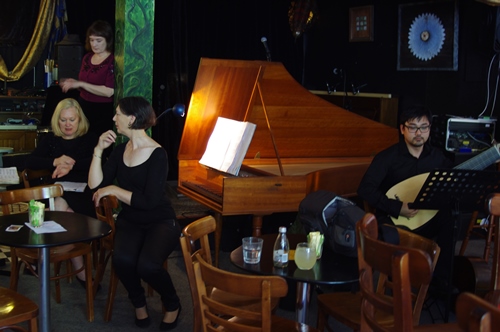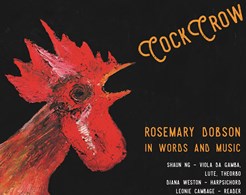
Leonie Cambage, Inara Molinari, Diana Weston, Shaun Ng waiting to start

Artwork by Isabel Doraisamy
Cock Crow
‘Dobson write(s) poems that are beautiful without being precious, challenging without being obscure, and that strive for timelessness without losing sight of what grounds them to reality.’ David McCooey
Rosemary Dobson, one of Australia’s greatest poets, recorded eight of her poems during the ‘70’s for Poets on Record. Varied in subject and mood, they veer between nostalgia and defiance, elation and despair. Writing on many topics throughout her life, these poems presage the issues that came to preoccupy her time and again – motherhood, the place of women, and Australia. They are read alongside music that reflects aspects of the poem, with pieces from the 17th c. to the 21st by Bach, Vivaldi, and Australians Elena Kats-Chernin, May Howlett and others.
Smith’s Alternative, 76 Alinga St, Canberra, Saturday Nov 19 4 pm
Gleebooks, Glebe Point Rd, Glebe, Sunday Nov 20 3pm
The Rose Room, 51F Sunninghill Rd, Burradoo Nov 26, 4 pm
Mosman Art Gallery, Mosman, Sunday Nov 27 2016 3pm
Review
https://www.sydneyartsguide.com.au/cock-crow-rosemary-dobson-words-music-mosman-art-gallery/
‘This was no ordinary artistic performance. The dedication of the performers to the work and to their fellow artists created a rare intimacy. We all listened, hushed in silence and concentration, to this unique event. If you like poetry, and you like music and you want to hear more of Rosemary Dobson’s poems listen to this talented group of musicians when you get a chance.
Leonie Cambage gave a clear polished faultless recitation of the poetry. Shaun Ng displayed a mastery of both instruments. He is a Doctor of Musical Arts from Sydney University. Diana Weston’s playing demonstrated why her reputation for mastery of the harpsichord extends beyond Australia.’ John Pollack, Sydney Arts Guide
The music chosen to sit side-by-side with Rosemary’s poems may reflect only one aspect of the poem, though sometimes many. It may be the character, the mood, a reminiscence, an impression, a story. The choices are personal and many more could be found that were equally applicable. One thing is apparent – that music and poetry have a lot in common in expressing the human soul.
One Section
Phillip Bolliger: Greek Dances Nos. 9, 5, 8, 6 Santorini, Mikonos, Kos, Patmos
Each dance represents a ‘section’ or stage of life as the tram passes through time. They make reference to Australia’s influx of Greek immigrants who helped shape our present culture; are, in fact Australian/Greek themselves. They acknowledge too, Rosemary’s fascination with Greek mythology. The first, Santorini, represents a young girl, light-hearted and innocent, cheeky even; in the second, Mikonos, she is older, ready to dance, full of joyous energy, even a little intoxicated; in the third, Kos, she is more sedate. She is waiting – for her partner? for life? The dance suggests movement, but in fact goes nowhere. Patmos, the last dance, is a Variations on a ground bass reminiscent of a chaconne, a dance often associated with separation. This and its measured, slow pace presage the final departure – death, the end of the ‘section’.
The Devil and the Angel
Antonio Vivaldi (1678-1741): Concerto in D major for lute and strings
Rosemary recorded only the first stanza of The Devil and the Angel. We would love to read it all but can’t for reasons of time – so have chosen two ‘scenes’ to demonstrate the quirky take on the subject of death that Rosemary adopts.
Rosemary’s son Ian Bolton, himself a musician, informed me that this was one of her favourite pieces of music. No other recommendation was required, as Shaun needed little excuse to acquire a new lute and master this typical work by Vivaldi. Marked by stark contrasts of texture, tempi, dynamics and mood, and full of imaginative detail, we think it sits very well with Rosemary’s amusing poem about an unlikely relationship between the equally contrasting devil and angel – personages well known, no doubt, to the Red Priest.
Country Press
May Howlett: Baroqua Rag
Baroqua Rag, like Country Press, hails back to a by-gone age. May Howlett nods to the baroque era in taking a well-known theme by Bach, but then turns it into a dance from the ‘20’s, itself an age gone past. Both piece and poem are imbued with nostalgia, but also more than a touch of humour.
The Bystander
Geoffrey Allen: The Bystander
Geoffrey Allen set 4 songs to poems by Rosemary Dobson – one of them The Bystander which reveals both her abiding interest in art, and her deep knowledge of it. Allen’s strophic setting has a modest little melody following the line of the poem with little variation. The accompaniment however, which incrementally shifts in emphasis as the observer wistfully notes her emotional detachment, subtly changes with each repetition, and is full of background detail.
The Birth
Ennemond Gaultier (1575-1659): Le tombeau de Mezangeau
Gaultier’s intensely moving, inward-looking piece for lute (‘tombeau’ meaning literally ‘tomb’ or ‘tombstone’) is an elegy or commemoration (of the death of his teacher Mezangeau) as is The Birth.
Cock Crow
Johann Sebastian Bach (1685-1750): Sinfonia No. 4 in D minor BWV 790
Two themes run parallel in Bach’s sinfonia, sometimes broken apart, sometimes appearing in three parts. Both repeatedly reach upwards, only to be knocked back. The plodding bass theme moves slowly because the top line has so much happening – turns and slides and trills and what-all – that there is hardly time to breathe, or make sense of all this interconnection of parts. Two pages of frustration, confusion, despondency, and final resolution.
This is Cock Crow, Rosemary’s signature poem for Poets on Record. Caught between the one and the other – her daughter and her mother. A mother herself, but also a poet and thinker – and no time for herself. Would she could, she would remove herself. But that would be betrayal.
The Rape of Europa
Tim Dargaville: Under Freshwater
Rosemary’s fascination with Greek mythology is evident in this early poem. At the same time, it is intensely Australian in its depiction of the river-bank. She marries the two in re-creating the story of her own translocation. Dargaville is unusual in his evocation of a world underwater. And doubtless it is an Australian river – slow-moving, beautiful and enticing yet hiding danger in its murky waters and deep pools – snags, eddies, currents….and gods.
Jack
Elena Kats-Chernin: Dance of the Paper Umbrellas
Fragile, light, easily broken, toys for children – that’s what springs to mind with paper umbrellas, and jack-in-boxes. Elena Kats-Chernin’s piece is cut in squares – 4/4 time, regular rhythm, 4 pages long, 4-bar phrases that twist and turn but cannot escape their sameness. Just like the box Jack sits in. And like Jack, there is a sadness in the inflections, a wistfulness in the constraint. The end is abrupt – the lid snapped shut.
